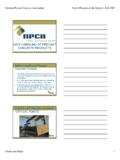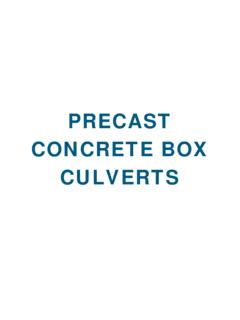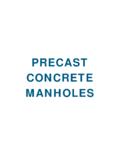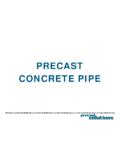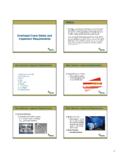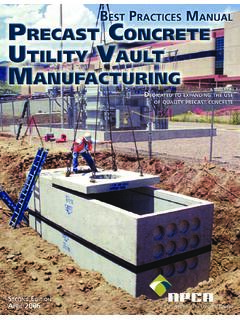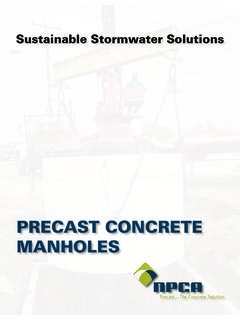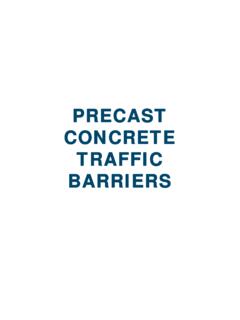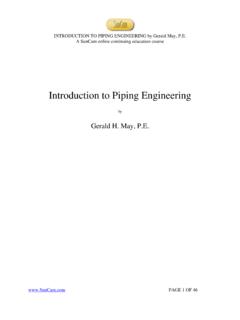Transcription of MANHOLE SIZING RECOMMENDATIONS - Precast
1 MANHOLE SIZING RECOMMENDATIONSN ational Precast Concrete Association 1320 City Center Dr., Suite 200 Carmel, IN 46032 manholes are the most widely used maintenance utility structures that provide access to pipelines for inspection and cleanout. Manholes are used for connecting two or more converging storm or sanitary sewers, permitting pipe size changes, accommodating abrupt changes in alignment or grade and allowing for direct surface flow interception. The largest impact on the size of these structures is the diameter and angle of entrance of the intersecting pipe. This document provides a guideline for SIZING round MANHOLE structures for various sizes and angles of incoming ConsiderationsTwo main design criteria in designing manholes, are that they must be large enough to accept the maximum pipe size, and the minimum structural leg width between pipe holes must be maintained.
2 The minimum pipe opening is assumed to be the pipe s inside diameter plus the wall thickness. The minimum structural leg is, as a practical minimum, 6 inches. Anything less than this width may allow cracking, which can lead to leakage, structural distress or durability concerns. A typical additional over SIZING of no more than 4 inches larger than the outside diameter of the pipe is used for the cutout. The final cutout or opening, therefore, includes all of these design provisions with respect to all other pipe openings, relative pipe elevations and vertical type of pipe entering the structure, and the connection method (boot, compression or mortar) must be known to accurately determine the required holes size and consequently, the MANHOLE possible, avoid pipes entering into structure joints and corners, as this may compromise the structural integrity and watertightness of the structure.
3 However, this practice may be necessary for certain installations and should be left to the discretion of an experienced Precast concrete consult your local Precast concrete manufacturer and connector supplier for exact design requirements and product MethodThe following is a method that can be used to determine minimum MANHOLE size for as many as three incoming pipes. (For installations where more than three pipes enter a MANHOLE , the design equations in the Appendix must be used. ) The formulas are: One Pipe: 180 > K Two Pipes: 180 > X > (K1+K2)/ 2 Three Pipes: 180 > X > (K1+K2)/ 2 and X + (K2+K3)/ 2 < Y < 360 - (K1+K2)/ 2 Where K represents the K Factor that can be found in the tables that follow for different types of and Y are the angles between the pipesReference PipePipe Diameter (inches) MANHOLE Diameter48 in60 in72 in84 in96 in108 in120 in72----15412010266----1291069260---1421 1 2958354---11998847448--13110286756642-15 41098875665836-1189176655751331801068470 6053473013696766455494427117866958514540 2410377635346413621906956484137331879615 0433733291568534437332926125946383228252 3 RCP AND HDPE PIPE K FACTORPipe Diameter (inches)
4 MANHOLE Diameter48 in60 in72 in84 in96 in108 in120 in64--16911797837360--14010790786954--12 49883726448-1421048573635742-11 5897463565036135957664554843301057964544 7413724836452443934312070554538333027186 4504135312725165846383228252214534234292 6232012473731262320181042332723211816837 292421181614631252118151412 PVC AND DUCTILE IRON PIPE K FACTORPage 2 of 4 NPCA MANHOLE INSTALLATION GUIDE (Inches) MANHOLE Diameter48 in60 in72 in84 in96 in108 in120 in72---141111948366---12199857560--13810 689776854--11 69379696148-1341008270615542-11086726254 48361289274625347423311 3846857494439301017662524640362791695748 4237332481635144383430217256463934302718 6350413530272415554336312724211247373126 2320181042332824211816 CORRUGATED METAL PIPE K FACTORD esign TablesSince the wall thickness for the design of reinforced concrete pipe and high-density polyethylene pipe are similar, a standard Precast concrete C-wall pipe thickness was used for the development of the tables for these products.
5 For inlet pipes, which have greater total outside diameters than standard ASTM C76 C-wall pipes, you must use the design equations in the appendix to determine the acceptable MANHOLE design tables for PVC and ductile iron pipe were based on the outside pipe diameters specified in the AWWA C150 standards for ductile iron pipe. Profile wall PVC pipe that does not conform to the maximum ductile iron outside diameters may have to use either the RCP/HDPE or corrugated metal tables depending on which is closer to its cross-sectional corrugated metal pipe tables were developed using a wall thickness and a corrugation pattern for all sizes. Since there are a great number of corrugation depths available for this product, the designer should adjust the design values in the table equations presented in the Appendix of this document are simplified in the tables as previously noted for each pipe type.
6 These tables are used to determine the minimum size MANHOLE required for one, two and three pipes entering a single MANHOLE structure at various angles. The K factors are based on the pipe diameter including its wall thickness and an appropriate supporting wall between the entering pipe for each MANHOLE diameter. Maximum vertical cutoffs are limited to an 8-foot high Given: Two pipes entering a MANHOLE : 42-inch RCP and 36-inch PVC at 115 Find: Smallest size manholeSolution: For two pipes 180 > 115 > (K1 + K2)/ 2 Trial 1 (60-inch MANHOLE ) K1 (42-inch RCP)=154 (from RCP Table) K2 (36-inch PVC)=95 (from PVC Table) (154 + 95)/2 = 125 >115 Result: Not AcceptableTrial 2 (72-inch MANHOLE ) K1 (42-inch RCP)=109 (from RCP Table) K2 (36-inch PVC)=76 (from PVC Table) (109 + 76)/2 = 93<115 Result: AcceptableSummaryThe procedures presented in this document provide a quick and easy solution for estimating the optimal size for manholes depending on the incoming pipe and type of connections being used.
7 The ultimate design is the responsibility of the engineer, who must insure the angles are correct. The contractor must also obtain these angles in the field. If the pipe is installed at angles other than normal or 90 degrees to the MANHOLE , new calculations must be made. Page 3 of 4 NPCA MANHOLE INSTALLATION GUIDE 4 of 4 NPCA MANHOLE INSTALLATION GUIDE determination of acceptability of each entering pipe relative to all the other incoming pipe is based on the reference pipe, which is arbitrarily selected by the designer. For ease of design, it is best to use the largest pipe diameter as the reference pipe. The other incoming pipe are determined by their angle, x and y, to this reference pipe. The following illustration and corresponding equations are used for making these calculations:Reference PipePipe OpeningPipe AnglePipe EquationAngle RangeReference Pipe(d1)0 A = 2 [sin-1 d1/r]NonePipe 2(d2)X B = 2 [sin-1 d2 /r]X - B / 2 > A / 2 Pipe 3(d3)Y C = 2 [sin-1 d3 /r]Y - C / 2 > X + B / 2and 360 - Y - C / 2< A / 2 DESIGN PARAMETERSW here: d = [ (pipe inside diameter) + pipe wall thickness + 5](all units in inches)
